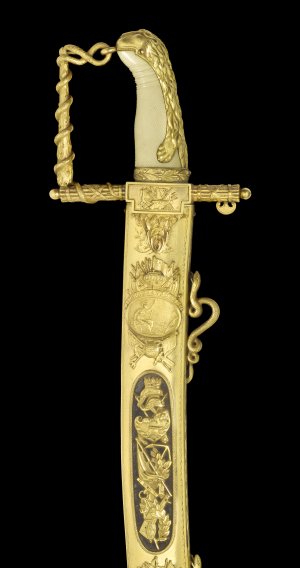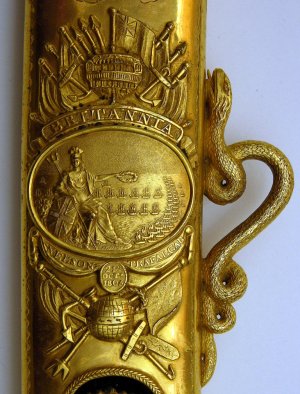Background
|
The Lloyd's Patriotic Fund, which was originally established as the Patriotic Fund, was inaugurated at a meeting on the 28th July 1803 at Lloyd's Coffee House. On previous occasions Lloyd's had raised money for casualties and their dependants at various actions but this time the Patriotic Fund received support from all over the British Empire. In fact, by March 1804, the Fund had received over £174,000, a massive amount by the standards of the day. The Patriotic Fund Committee was not only able to grant money to the wounded and give annuities to the dependants of those killed but also to reward those who distinguished themselves with "successful exertions of value or merit". These rewards took the form of a piece of plate, a sword or a sum of cash. A competition was organized for the design of these rewards and that put forward by John Shaw was selected for a handsome vase. There was no prize given for the design of the sword but the contract for making them was given to Richard Teed of Lancaster Court, Strand, London.
There were to be three types of sword awarded. One of £100 value would be given to commanders and naval captains, the £50 sword was given to naval lieutenants and Royal Marine captains and a £30 sword was awarded to midshipmen, masters' mates and Marine Lieutenants. The design of the ormolu stirrup hilt of each sword was identical, the knuckle-guard is in the form of the club of Hercules entwined by a snake, the quillons are Roman fasces, the langets are cast with acanthus foliage and applied with naval trophies, the back-piece is in the form of the Nemean Lion skin. The grip is of chequered ivory. The blade is of the type fitted to the British 1796 Pattern Light Cavalry sabre. The £100 sword blade is etched, blued and gilded with foliage, naval trophies, the Royal Arms and cypher, and the figure of Britannia. The £50 blade is similar but not quite so ornate and both have the presentation inscription on one side in gilt Roman capital letters against a blued ground. On £30 swords the inscription is etched and gilt against a matt ground. |
 Image courtesy of Bonhams |
 |
 |
 Images courtesy of Bonhams |
There are some variations between swords of the same value, especially on those produced after the official presenting of rewards ceased.
Each sword came in a mahogany case with brass escutcheon engraved with the recipient's name and the name of his ship and was accompanied by a blue and gold bullion sword knot and a sword belt, that for the £100 sword being more ornate than for the others. Inside the lid of the case was a label which explained the classical iconography of the hilt. Each recipient also received a letter sometimes referred to as a certificate or citation with a beautiful engraving of Britannia and a lion surrounded by naval trophies above a hand-written address to the recipient detailing the action concerned. These were hand written by young boys from Christ's Hospital, London.

Image courtesy of Bonhams
How Many
In 1970 May & Annis published a list of Patriotic Fund swords. Since then swords have appeared that were not included on this list and others have been shown not to exist. The "new" swords are generally late pieces. At a General Meeting of Subscribers held on 24th August 1809 it was decided to concentrate on awards to the wounded and dependants of those killed and discontinue awards for merit because of the huge demands being put on the Fund by the battles in the Peninsular War. However, some officers who were awarded sums of money for wounds received applied to the Fund for permission to have a sword with suitable inscription made. Generally the officers ordered the swords directly from Teed, but, in the case of Captain Brenton, the Fund paid Teed directly and Captain Fleming of the 31st Regiment received a mameluke hilted sabre made by Brun.Having studied the various lists available and compared them with the Lloyd's accounts with Richard Teed, it would appear that the number of swords produced was as follows:
| £30 | 15 |
| £50 | 91 |
| £100 | 36 |
| £100 Trafalgar | 23 |
| 165 - Total |
It must be borne in mind that over sixty officers chose to receive a piece of plate instead of a sword. Also a number decided to accept their award in cash. In some cases this was for charitable purposes such as distributing to wounded crew members but some must have just preferred to take the money.
Where are they now
The idea of this website is to trace as many swords as possible. No doubt over the last 200 years some will have been lost or destroyed but the fact that they would have been impressive and treasured items means that the majority are sure to have survived.
The criteria for categorising a sword as "traced" are as follows:
- Seen in a public collection or museum
- Seen in a private collection
- Sold at auction in the last 50 years
- Illustrated in a published work in the last 50 years
- Details on a web-site of a public collection or museum
- Confirmed to be in a private collection by a number of distinguished sources
The basis for including categories 3) and 4) is that if a sword has been auctioned or documented within that period its importance and value is expected to be recognised and it is assumed to be held within a public or private collection. The table below shows the number of swords awarded, recorded and traced categorized by the four levels of award:
| Type | Awarded | Recorded | Traced | Not Presented |
| £30 | 16 | 15 | 12 | 1 |
| £50 | 100 | 91 | 69 | 9 |
| £100 | 40 | 36 | 31 | 4 |
| Trafalgar | 25 | 23 | 21 | 2 |
| Total | 181 | 165 | 133 | 16 |
Of the 133 swords traced, 81 are in private collections (68) and family ownership (13). The remaining 52 swords are in museums and public collections. The largest collections are the 13 swords held in the Lloyd's of London collection and 13 swords (6 of which are Trafalgar swords) held by the National Maritime Museum. This is followed by 7 swords at the Royal Naval Museum in Portsmouth and 4 swords at the Royal Marines Museum in Southsea. The primary objective of this website is to discover if there are further swords out there and the authors sincerely hope that collectors, curators, researchers and dealers will make contact with information surrounding further sightings or knowledge. In this endeavour we will absolutely protect confidentiality and are not seeking to know any details of current ownership or location rather the existence of the sword. It is intended that this website will be regularly updated as new details emerge.
We would sincerely appreciate any information that updates our current understanding of the whereabouts in particular of the "untraced swords". Please address any comments or information to: info@lloydsswords.com
Additional Reading.....
Comments regarding the awarding of Badges of Valour by the Lloyd's Patriotic Fund (1803-1809). by Sim Comfort
All content © copyright ‘Lloydsswords.com’ All rights reserved 2011 | Design © copyright Mark Cloke 2011
 www.OldSwords.com....the largest online resource for the antique sword collector. |
Sword Forum |







